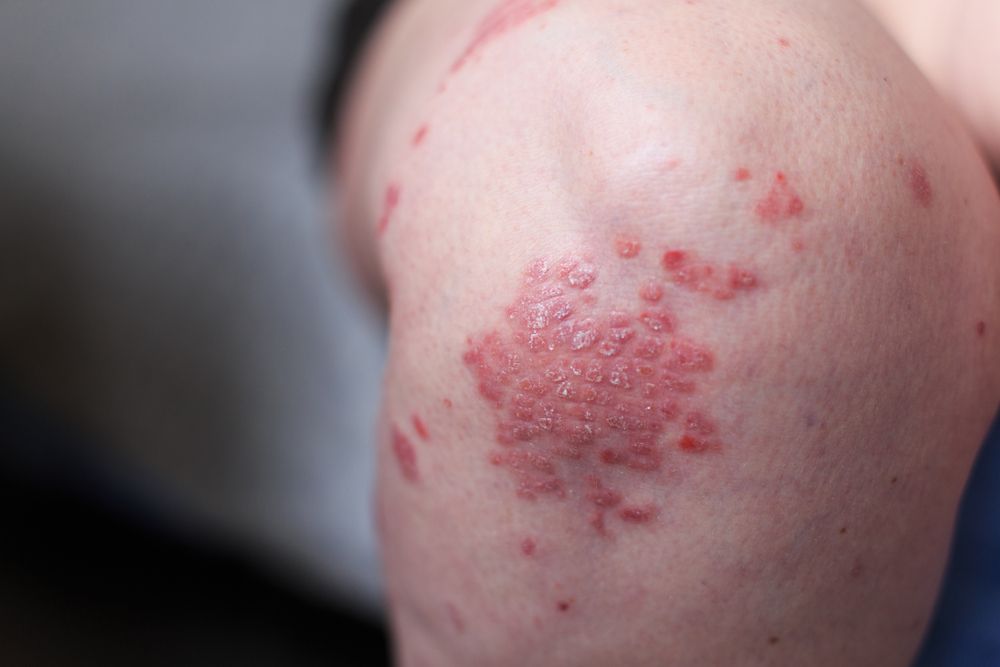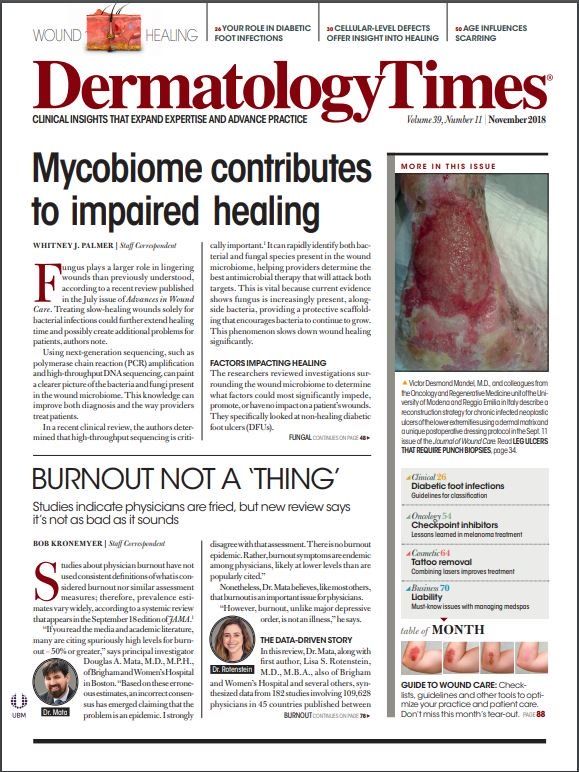- Case-Based Roundtable
- General Dermatology
- Eczema
- Chronic Hand Eczema
- Alopecia
- Aesthetics
- Vitiligo
- COVID-19
- Actinic Keratosis
- Precision Medicine and Biologics
- Rare Disease
- Wound Care
- Rosacea
- Psoriasis
- Psoriatic Arthritis
- Atopic Dermatitis
- Melasma
- NP and PA
- Skin Cancer
- Hidradenitis Suppurativa
- Drug Watch
- Pigmentary Disorders
- Acne
- Pediatric Dermatology
- Practice Management
- Prurigo Nodularis
- Buy-and-Bill
Publication
Article
Dermatology Times
Wound healing in psoriasis, multiple sclerosis
Author(s):
Wound healing is impaired in both psoriasis and multiple sclerosis. Understanding the pathophysiology of these two chronic conditions is vital to generating and improving treatment targets.
Wound healing is impaired in both psoriasis and multiple sclerosis. Understanding the pathophysiology of these two chronic conditions is vital to generating and improving targets for treating them. (©TernavskaiaOIgaAlibec/Shutterstock.com)

Wound healing is impaired in both psoriasis and multiple sclerosis, raising the prospect that a better understanding of the process could improve our understanding of the pathophysiology of these two chronic conditions and generate targets for treating them.
The two conditions share a number of characteristics.
For example, both diseases demonstrate slight itching, symmetry of the lesions, exacerbation after stopping corticosteroid treatment, and the Koebner phenomenon – provocation of the condition by stress.
The Koebner phenomenon (isomorphic response) was first described in 1876 by the German dermatologist Heinrich Koebner who noted that patients developed psoriasis at sites of excoriations, horse bites, and tattoos.
Koebner famously saw a psoriatic plaque develop on the skin of a farmer where his horse, attempting to get to the sugar he kept in his trouser pocket as a treat, had bitten him, noted Vera B. Morhenn of the department of dermatology, San Francisco VA Medical Center in San Francisco, California in an article for Advances in Wound Care, in a review of the relationship between wound healing, psoriasis and multiple sclerosis published online in Advances in Wound Care.i
“Stress has been reported to be a provoking factor for the first and subsequent flares of MS,” she says. “The occurrence of the Koebner phenomenon in psoriasis and MS suggests that the etiology of both of these diseases may relate to defects in the wound healing process.”
Wound healing occurs in four stages:
- hemostasis
- inflammation
- proliferation
- maturation
Keratinocytes and oligodendrocytes play key roles in the process.
Keratinocytes are the predominate cell in the epidermis so must be able to respond quickly to repair any damage. They synthesize a large number of cytokines including tumor necrosis factor alpha (TNFα), vascular endothelial growth factor (VEGF), and both the constitutive and inducible forms of nitric oxide synthase, Dr. Morhenn writes.
Oligodendrocytes are non-neural cells of ectodermal origin that form part of the adventitial structure of the central nervous system.
Keratinocytes and oligodendrocytes produce nitric oxide (NO) – a gas that is important in vasodilation and immune andinflammatory responses - and is a vital component of wound healing. NO stimulates keratinocyte proliferation, enhances their expression of VEGF, and activates their production of epidermal growth factor (EGF) receptor ligands. The synthesis of EGF results in an autocrine loop and proliferation of keratinocytes.
In psoriasis, the proliferation of keratinocytes does not stop when the wound has re-epithelialized and in MS repair of the myelin sheath which protects the nerves is not initiated or stops before the wound healing process is completed.
WHAT GOES WRONG IN PSORIASIS
Elevated intracellular calcium ion concentrations in keratinocytes mean that they do not differentiate, significantly increasing the rate of wound healing, according to Dr. Morhenn.
VEGF, a potent stimulator of angiogenesis, and its receptors VEGFR-1 and -2 have been shown to be overexpressed by keratinocytes in the suprabasal layers of the epidermis of psoriatic plaques, as well as, by dermal fibroblasts, implying a dermally derived influence on neovascularization, she writes.
Serum VEGF-A concentrations are also mACh-R, and can improve wound healing. Benztropine has also been shown to stimulate oligodendrocyte precursor cells’ differentiation and remyelination in an animal model of MS.
“The skin-related events appear to mimic the events occurring in the central nervous system when damaged nerves are remyelinated,” writes Dr. Morhenn. “That the nervous system plays a role in psoriasis is suggested by the finding that severing of a nerve in one area of the body leads to healing of the psoriatic plaques in this area while the plaques on the contralateral side do not improve. Furthermore, injecting Botox, a medication that blocks the ACh-R, into a psoriatic plaque results in clearing of only that lesion.”
THE ROLE OF WOUND HEALING IN MS
MS is characterized by decreasing motor strength, numbness and does not affect the skin, except for pruritus.
Nitric oxide release by oligodendrocyte precursor cells causes differentiation, but does not lead to remyelination. Since damage to the myelin sheath occurs in a “sterile” environment, writes Dr. Morhenn, the innate immune system is not activated, and the later stages of wound healing, proliferation, and maturation not initiated. “The defect in the wound healing response in MS could also relate to a failure in the switch of the resident macrophages from the inflammatory to the anti-inflammatory phenotype,” she adds. “By contrast, in areas of the skin that express the psoriatic phenotype, one of the antimicrobial peptides, LL-37, is highly expressed, and, therefore, the wound healing response would likely be initiated.”
There is clearly a relationship between the two conditions, she emphasizes.
“Individuals with psoriasis have a significantly higher risk of developing MS and the more severe the psoriasis is, the more likely the individual will develop MS,” she writes.
TNFα inhibitors have been used to improve psoriasis, although sometimes they can induce the disease, as well as worsen the symptoms of MS or even induce MS, Dr. Morhenn adds.
“The many similarities in the pathophysiology documented in psoriasis and MS, as well as in wound healing, suggest that further basic research in these two autoimmune diseases may lead to a better understanding of wound healing. Furthermore, these insights may, in turn, suggest novel therapies for psoriasis and MS,” Dr. Morhenn concludes.
REFERENCES
1. Morhenn VB. The Relationship of Wound Healing with Psoriasis and Multiple Sclerosis. Adv Wound Care (New Rochelle). 2018 Jun 1; 7(6): 185–188. Published online 2018 Jun 1. doi: 10.1089/wound.2017.0773
2. Diani M, Cozzi C, Altomare G. Heinrich Koebner and His Phenomenon. JAMA Dermatol. 2016;152(8):919.






